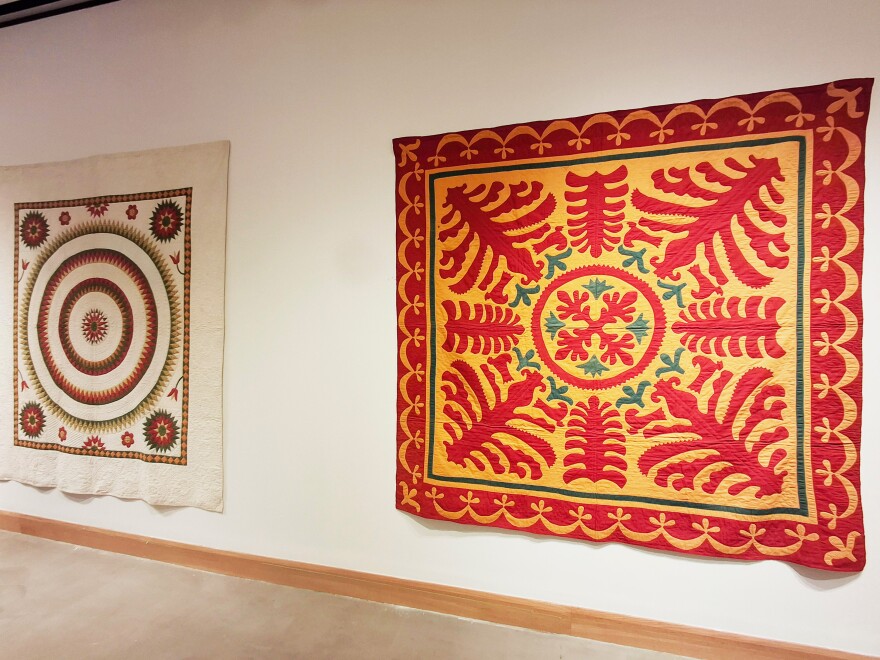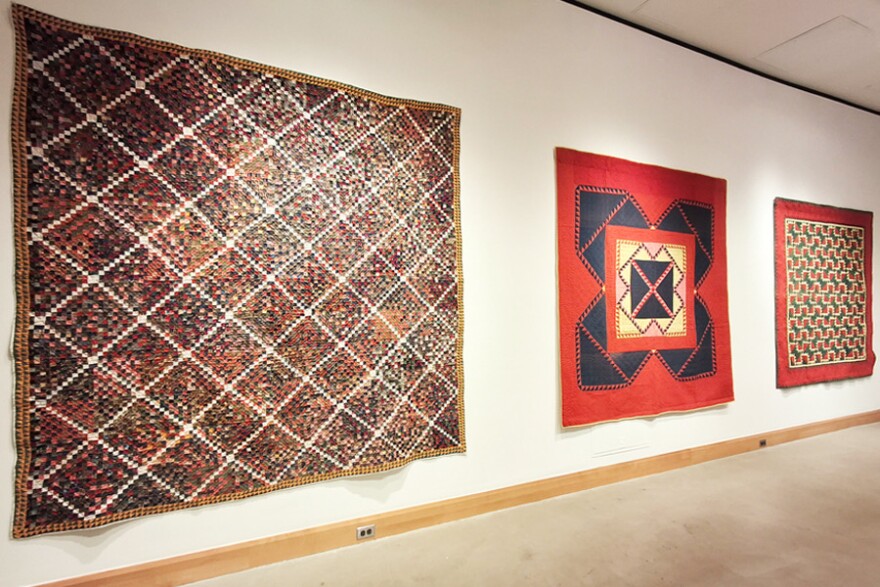ALLENTOWN, Pa. — The walls and ceilings come alive with color, fabric and the vibrant traditions of Pennsylvania Dutch and German culture at Allentown Museum's newest exhibition.
"Cutting Edge: Inventive Nineteenth-century Quilts" will debut Saturday, Aug. 9, inside the museum's Scheller and Fowler Galleries.
The exhibit, which features more than 30 quilts from the collection of Arlan and Pat Christ, will run through Oct. 26. Admission to Allentown Art Museum is free.Allentown Art Museum
The exhibit, which features more than 30 quilts from the collection of Arlan and Pat Christ, will run through Oct. 26.
Admission to Allentown Art Museum is free.
On Saturday, the museum's Associate Curator, Claire McRee, will lead a tour and share stories uncovered through her genealogical research on certain quilts and their makers.
Rather than focusing solely on conventional quilting patterns, "Cutting Edge" highlights quilts as acts of self-expression —works in which invention builds on creating something richer and unique.
"It was partly something that I was curious about for myself," McRee said.
"A lot of times with quilting, we think about the tradition and the following patterns and designs that are handed down through generations.

"And I was wondering about where the experimentation and innovation were hiding and how we could bring those stories forward."
The quiltmakers who experimented
Several of the quilts on display, with some never having been on public display, hail from Lancaster, Reading and Berks County.
McRee said the exhibition reveals pieces that showcase women quiltmakers, engaging in geometric experimentation and abstraction long before modern painters approached similar ideas in the 20th century.
"I think it's fascinating to have them in an art museum and think about bringing this alternate art form into the space of the museum."Allentown Art Museum Associate Curator Claire McRee
Though quilts often were seen as “domestic objects” during that era, McRee said their skilled craftsmanship deserves recognition equal to that of a painting.
"I think it's fascinating to have them in an art museum and think about bringing this alternate art form into the space of the museum," she said.
"There's so much design, sensibility and creativity that goes into the quilts, just as the paintings we have on view."
On display are quilts that date to the mid-1800s.
Quilts with small mysteries
One distinctive pattern, from Berks County, features snowflake-like designs reminiscent of Pennsylvania German paper-cutting.
McRee said that Pennsylvania German quilts, in particular, stand out for their vivid colors and avoidance of plain white backgrounds.
Another stand-out piece, "Whole Cloth Quilt," was designed in the late 18th or early 19th century.
The quilt contains small mysteries, McRee said, including unevenly printed medallions, perhaps the result of home printing to save money, and quilted hand silhouettes.
"When you start to look closely at the quilts, you can think about all these questions and stories," she said.
"Was it something that was planned out? Did the silhouettes of hands in the background belong to family members, or did the quilters who worked on it trace their hands as a way of signing it?"
"We can’t know for sure, but details like that connect us to the makers in a deeply human way.”

Floating from the ceiling
Displaying the quilts brought challenges.
Each piece is large, requiring careful spacing, lighting and support, McRee said.
The Christs added fabric sleeves to the backs, allowing the weight to be evenly distributed on hanging bars.
“It’s easy to glance at a quilt and just register it as a quilt. But if you stop and study it, you’ll see choices in color, pattern, and construction that tell stories. Stories of the women who made them, the communities they lived in, and the artistry they poured into every stitch.”Allentown Art Museum Associate Curator Claire McRee
But the gallery space is filled with color, because of some quilts even floating from the ceiling.
The pieces also are hung back-to-back, so visitors can look at the rarely seen reverse sides.
On Sept. 6, the Christs will hold a “quilt turning," where additional treasures from their extensive collection will be unfurled and discussed.
McRee said she hopes visitor to the "Cutting Edge" exhibition will slow down and seek out the details woven in each quilt.
“It’s easy to glance at a quilt and just register it as a quilt,” she said. “But if you stop and study it, you’ll see choices in color, pattern, and construction that tell stories.
"Stories of the women who made them, the communities they lived in, and the artistry they poured into every stitch.”
For more information, go to the Allentown Art Museum's website.


